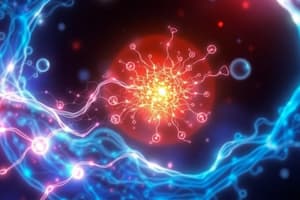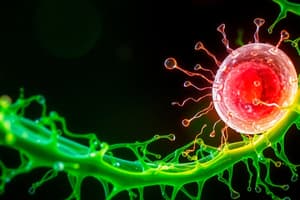Podcast
Questions and Answers
What is the primary function of local regulators in cell communication?
What is the primary function of local regulators in cell communication?
- To target and influence nearby cells. (correct)
- To enable long-distance signaling between different cell types.
- To act as a secondary messenger in signal transduction.
- To assist in cell adhesion during immune responses.
What type of receptor is known for its role in signal transduction in eukaryotic cells?
What type of receptor is known for its role in signal transduction in eukaryotic cells?
- Ligand-gated ion channels
- G protein-coupled receptors (correct)
- Tyrosine kinase receptors
- Intracellular hormone receptors
Which component of a signal transduction pathway is responsible for amplifying the signal once a ligand binds to a receptor?
Which component of a signal transduction pathway is responsible for amplifying the signal once a ligand binds to a receptor?
- The ligand itself
- The cell's nucleus
- Cyclic AMP as a second messenger (correct)
- The receptor protein
How do hormones typically communicate with target cells over long distances?
How do hormones typically communicate with target cells over long distances?
In what way does quorum sensing influence cellular responses?
In what way does quorum sensing influence cellular responses?
What initiates the signal transduction process when a ligand binds to its receptor?
What initiates the signal transduction process when a ligand binds to its receptor?
What role do second messengers play in signal transduction pathways?
What role do second messengers play in signal transduction pathways?
What is the effect of mutations in receptor protein components of a signaling pathway?
What is the effect of mutations in receptor protein components of a signaling pathway?
How does negative feedback maintain homeostasis?
How does negative feedback maintain homeostasis?
Which process is characteristic of positive feedback mechanisms?
Which process is characteristic of positive feedback mechanisms?
What is the primary purpose of mitosis in cell division?
What is the primary purpose of mitosis in cell division?
How do cyclins and cyclin-dependent kinases regulate the cell cycle?
How do cyclins and cyclin-dependent kinases regulate the cell cycle?
What type of changes can be caused by alterations in signaling molecules?
What type of changes can be caused by alterations in signaling molecules?
What is usually the consequence of disruptions in the cell cycle?
What is usually the consequence of disruptions in the cell cycle?
In which phase of the cell cycle does DNA replication occur?
In which phase of the cell cycle does DNA replication occur?
What role do checkpoints play in the cell cycle?
What role do checkpoints play in the cell cycle?
Which is a characteristic function of cytokines in signal transduction?
Which is a characteristic function of cytokines in signal transduction?
Flashcards
How do cells communicate?
How do cells communicate?
Cells use direct contact or chemical signaling to communicate. Direct contact involves physical touch between cells, like immune cells or plant cells connected by plasmodesmata. Chemical signaling uses messenger molecules released from one cell to signal another.
What is local signaling?
What is local signaling?
Local regulators target cells in close proximity to the signal-emitting cell. Examples include neurotransmitters, which signal between neurons, and morphogens, which guide embryonic development.
What is long-distance signaling?
What is long-distance signaling?
Long-distance signaling involves signals that travel from one cell type to another, often across long distances. Hormones, such as insulin or estrogen, are examples of long-distance messengers.
What is a signal transduction pathway?
What is a signal transduction pathway?
Signup and view all the flashcards
What is a ligand?
What is a ligand?
Signup and view all the flashcards
What are second messengers?
What are second messengers?
Signup and view all the flashcards
How can the environment affect signal transduction?
How can the environment affect signal transduction?
Signup and view all the flashcards
What are the types of cellular responses triggered by signal transduction?
What are the types of cellular responses triggered by signal transduction?
Signup and view all the flashcards
How do changes in signal transduction affect signaling pathways?
How do changes in signal transduction affect signaling pathways?
Signup and view all the flashcards
What is negative feedback and how does it maintain homeostasis?
What is negative feedback and how does it maintain homeostasis?
Signup and view all the flashcards
What is positive feedback and how does it affect homeostasis?
What is positive feedback and how does it affect homeostasis?
Signup and view all the flashcards
What is the cell cycle?
What is the cell cycle?
Signup and view all the flashcards
What is mitosis and what is its purpose?
What is mitosis and what is its purpose?
Signup and view all the flashcards
What are the stages of mitosis?
What are the stages of mitosis?
Signup and view all the flashcards
How is the cell cycle regulated?
How is the cell cycle regulated?
Signup and view all the flashcards
What happens if the cell cycle is disrupted?
What happens if the cell cycle is disrupted?
Signup and view all the flashcards
Study Notes
Cell Communication
- Cells communicate via direct contact (e.g., immune cells, plasmodesmata) or distance signaling using chemicals.
- Short-distance communication uses local regulators targeting nearby cells (e.g., neurotransmitters, plant immune response, quorum sensing, morphogens).
- Long-distance communication involves signals traveling to distant target cells (e.g., hormones like insulin, growth hormone, thyroid hormones, testosterone, estrogen).
Signal Transduction
- Signal transduction pathways connect signal reception to cellular responses.
- These pathways frequently involve protein modification and phosphorylation cascades.
- Signaling starts with a ligand binding to a receptor protein.
- The receptor's ligand-binding domain recognizes specific ligands (peptides, small chemicals, or proteins).
- G protein-coupled receptors are an example of eukaryotic receptor proteins.
- Signaling cascades relay signals, amplifying them for cellular responses (growth, secretion, gene expression).
- The receptor's intracellular domain changes shape, initiating signal transduction.
- Second messengers (e.g., cyclic AMP) relay and amplify intracellular signals.
- Ligand-gated channels open or close in response to ligand binding.
Environmental Influence on Cellular Responses
- Signal transduction pathways allow cells to respond to the environment (e.g., quorum sensing in microbes, epinephrine stimulating glycogen breakdown).
- Outcomes include changes in gene expression, cellular function, phenotype alteration, or apoptosis.
Feedback Mechanisms
- Feedback mechanisms maintain homeostasis (internal environment stability) and respond to changes.
- Negative feedback mechanisms return a system to its set point when perturbed (e.g., blood sugar regulation by insulin/glucagon).
- Positive feedback mechanisms amplify responses (e.g., lactation, childbirth, fruit ripening).
The Cell Cycle
- The eukaryotic cell cycle involves controlled growth and reproduction.
- Stages include interphase (G1, S, G2), mitosis, and cytokinesis.
- Cells can enter a non-dividing state (G0).
- Mitosis ensures a complete genome transfer to identical daughter cells for growth, repair, and asexual reproduction.
- Mitosis follows interphase and occurs in phases: prophase, metaphase, anaphase, telophase.
Cell Cycle Regulation
- Checkpoints regulate progression through the cell cycle.
- Cyclins and cyclin-dependent kinases (CDKs) interact to control the cycle.
- Disruptions to the cycle can lead to cancer or apoptosis.
Signal Pathway Changes
- Mutations in receptor proteins or signaling pathway components can alter signal transduction.
- Chemicals affecting pathway components can either activate or inhibit the pathway.
Studying That Suits You
Use AI to generate personalized quizzes and flashcards to suit your learning preferences.
Description
Explore the mechanisms of cell communication, including both direct contact and distance signaling through chemical messengers. This quiz covers short-distance communication and the intricacies of signal transduction pathways, highlighting the role of receptor proteins and the signaling cascades that lead to cellular responses.




